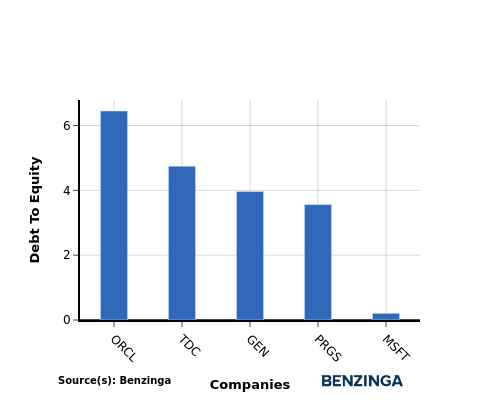In the fast-paced and cutthroat world of business, conducting thorough company analysis is essential for investors and industry experts. In this article, we will undertake a comprehensive industry comparison, evaluating Microsoft MSFT in comparison to its major competitors within the Software industry. By analyzing crucial financial metrics, market position, and growth potential, our objective is to provide valuable insights for investors and offer a deeper understanding of company's performance in the industry.
Microsoft Background
Microsoft develops and licenses consumer and enterprise software. It is known for its Windows operating systems and Office productivity suite. The company is organized into three equally sized broad segments: productivity and business processes (legacy Microsoft Office, cloud-based Office 365, Exchange, SharePoint, Skype, LinkedIn, Dynamics), intelligence cloud (infrastructure- and platform-as-a-service offerings Azure, Windows Server OS, SQL Server), and more personal computing (Windows Client, Xbox, Bing search, display advertising, and Surface laptops, tablets, and desktops).
| Company | P/E | P/B | P/S | ROE | EBITDA (in billions) | Gross Profit (in billions) | Revenue Growth |
|---|---|---|---|---|---|---|---|
| Microsoft Corp | 33.45 | 10.19 | 11.84 | 8.17% | $36.79 | $47.83 | 12.27% |
| Oracle Corp | 41.58 | 34.60 | 8.80 | 25.66% | $5.75 | $9.97 | 8.64% |
| ServiceNow Inc | 148.89 | 21.88 | 19.32 | 4.06% | $0.62 | $2.33 | 21.34% |
| Palo Alto Networks Inc | 47.84 | 20.47 | 15.81 | 6.33% | $0.45 | $1.58 | 13.88% |
| CrowdStrike Holdings Inc | 780.53 | 32.06 | 26.61 | -0.57% | $0.05 | $0.76 | 28.52% |
| Fortinet Inc | 50.69 | 85.14 | 13.62 | 90.26% | $0.66 | $1.24 | 13.0% |
| Gen Digital Inc | 26.64 | 7.71 | 4.34 | 7.48% | $0.45 | $0.79 | 4.01% |
| Monday.Com Ltd | 594.09 | 13.12 | 14.48 | -1.28% | $-0.02 | $0.23 | 32.67% |
| Dolby Laboratories Inc | 31.01 | 3.22 | 6.19 | 2.72% | $0.11 | $0.32 | 13.13% |
| CommVault Systems Inc | 41.91 | 24.34 | 7.63 | 3.9% | $0.02 | $0.21 | 21.13% |
| QXO Inc | 23.32 | 1.20 | 21.24 | -0.21% | $-0.03 | $0.01 | -2.0% |
| Qualys Inc | 30.77 | 11.35 | 8.83 | 10.53% | $0.05 | $0.13 | 8.36% |
| Teradata Corp | 37.54 | 24.43 | 1.76 | 32.0% | $0.08 | $0.27 | 0.46% |
| SolarWinds Corp | 67.64 | 1.86 | 3.25 | 0.94% | $0.07 | $0.18 | 5.5% |
| Progress Software Corp | 37.23 | 5.67 | 3.38 | 0.27% | $0.05 | $0.18 | 21.47% |
| Average | 139.98 | 20.5 | 11.09 | 13.01% | $0.59 | $1.3 | 13.58% |
Through an analysis of Microsoft, we can infer the following trends:
-
The stock's Price to Earnings ratio of 33.45 is lower than the industry average by 0.24x, suggesting potential value in the eyes of market participants.
-
The current Price to Book ratio of 10.19, which is 0.5x the industry average, is substantially lower than the industry average, indicating potential undervaluation.
-
With a relatively high Price to Sales ratio of 11.84, which is 1.07x the industry average, the stock might be considered overvalued based on sales performance.
-
The company has a lower Return on Equity (ROE) of 8.17%, which is 4.84% below the industry average. This indicates potential inefficiency in utilizing equity to generate profits, which could be attributed to various factors.
-
The company has higher Earnings Before Interest, Taxes, Depreciation, and Amortization (EBITDA) of $36.79 Billion, which is 62.36x above the industry average, indicating stronger profitability and robust cash flow generation.
-
The gross profit of $47.83 Billion is 36.79x above that of its industry, highlighting stronger profitability and higher earnings from its core operations.
-
The company's revenue growth of 12.27% is significantly below the industry average of 13.58%. This suggests a potential struggle in generating increased sales volume.
Debt To Equity Ratio

The debt-to-equity (D/E) ratio gauges the extent to which a company has financed its operations through debt relative to equity.
Considering the debt-to-equity ratio in industry comparisons allows for a concise evaluation of a company's financial health and risk profile, aiding in informed decision-making.
When assessing Microsoft against its top 4 peers using the Debt-to-Equity ratio, the following comparisons can be made:
-
Among its top 4 peers, Microsoft has a stronger financial position with a lower debt-to-equity ratio of 0.21.
-
This indicates that the company relies less on debt financing and maintains a more favorable balance between debt and equity, which can be viewed positively by investors.
Key Takeaways
For Microsoft in the Software industry, the PE and PB ratios suggest that the stock is undervalued compared to its peers. However, the high PS ratio indicates that the stock may be overvalued based on revenue. In terms of profitability, Microsoft's low ROE suggests lower returns compared to its peers, while the high EBITDA and gross profit indicate strong operational performance. The low revenue growth rate may be a concern for future prospects compared to industry peers.
This article was generated by Benzinga's automated content engine and reviewed by an editor.
Edge Rankings
Price Trend
© 2025 Benzinga.com. Benzinga does not provide investment advice. All rights reserved.
Trade confidently with insights and alerts from analyst ratings, free reports and breaking news that affects the stocks you care about.